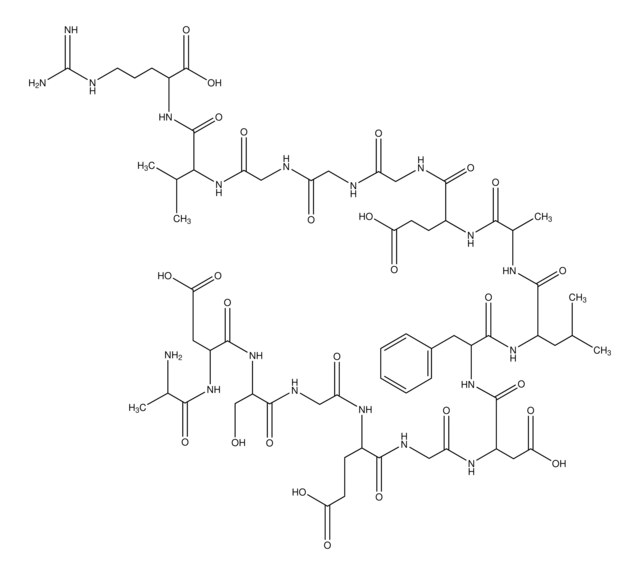Key Documents
About This Item
Polecane produkty
pochodzenie biologiczne
human
Próba
≥97% (HPLC)
Postać
powder
numer dostępu UniProt
temp. przechowywania
−20°C
ciąg SMILES
CC(C)C(NC(=O)CNC(=O)C1CCC(=O)N1)C(=O)NC(CC(N)=O)C(=O)NC(CC(O)=O)C(=O)NC(CC(N)=O)C(=O)NC(CCC(O)=O)C(=O)NC(CCC(O)=O)C(=O)NCC(=O)NC(Cc2ccccc2)C(=O)NC(Cc3ccccc3)C(=O)NC(CO)C(=O)NC(C)C(=O)NC(CCCNC(N)=N)C(O)=O
InChI
1S/C66H93N19O25/c1-31(2)53(85-49(91)29-73-55(99)35-16-19-47(89)75-35)64(108)83-42(26-46(68)88)61(105)82-43(27-52(96)97)62(106)81-41(25-45(67)87)60(104)78-37(18-21-51(94)95)57(101)77-36(17-20-50(92)93)56(100)72-28-48(90)76-39(23-33-11-6-4-7-12-33)58(102)80-40(24-34-13-8-5-9-14-34)59(103)84-44(30-86)63(107)74-32(3)54(98)79-38(65(109)110)15-10-22-71-66(69)70/h4-9,11-14,31-32,35-44,53,86H,10,15-30H2,1-3H3,(H2,67,87)(H2,68,88)(H,72,100)(H,73,99)(H,74,107)(H,75,89)(H,76,90)(H,77,101)(H,78,104)(H,79,98)(H,80,102)(H,81,106)(H,82,105)(H,83,108)(H,84,103)(H,85,91)(H,92,93)(H,94,95)(H,96,97)(H,109,110)(H4,69,70,71)
Klucz InChI
MYRIFIVQGRMHRF-UHFFFAOYSA-N
informacje o genach
human ... FGB(2244)
Amino Acid Sequence
Opis ogólny
Działania biochem./fizjol.
Kod klasy składowania
11 - Combustible Solids
Klasa zagrożenia wodnego (WGK)
WGK 3
Temperatura zapłonu (°F)
Not applicable
Temperatura zapłonu (°C)
Not applicable
Środki ochrony indywidualnej
Eyeshields, Gloves, type N95 (US)
Certyfikaty analizy (CoA)
Poszukaj Certyfikaty analizy (CoA), wpisując numer partii/serii produktów. Numery serii i partii można znaleźć na etykiecie produktu po słowach „seria” lub „partia”.
Masz już ten produkt?
Dokumenty związane z niedawno zakupionymi produktami zostały zamieszczone w Bibliotece dokumentów.
Nasz zespół naukowców ma doświadczenie we wszystkich obszarach badań, w tym w naukach przyrodniczych, materiałoznawstwie, syntezie chemicznej, chromatografii, analityce i wielu innych dziedzinach.
Skontaktuj się z zespołem ds. pomocy technicznej

![[Glu1]-Fibrinopeptide B human ≥90% (HPLC)](/deepweb/assets/sigmaaldrich/product/structures/122/537/7ead5c32-cb67-4325-9ce7-66c8dec24bdd/640/7ead5c32-cb67-4325-9ce7-66c8dec24bdd.png)

![[D-Ala2]-Leucine enkephalin ≥97% (HPLC)](/deepweb/assets/sigmaaldrich/product/structures/205/481/4fd123c0-14c7-4f90-8bdc-9e54a4bea7f1/640/4fd123c0-14c7-4f90-8bdc-9e54a4bea7f1.png)



